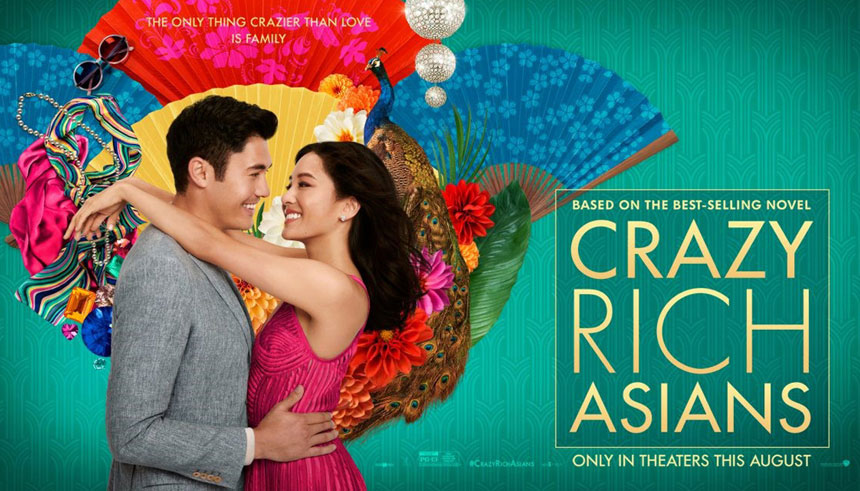Now Showing: Crazy Rich Asians
Over the 108 years of Hollywood filmmaking, Asians have not been well represented. Whether Mickey Rooney’s portrayal of Mr. Yunioshi in “Breakfast at Tiffany’s” or a stereotyped character good at math or martial arts, Asians have been whitewashed and underrepresented on the big screen.
“Crazy Rich Asians,” a book-to-film adaption with an all-Asian cast, sets out to break this mold. With $117 million in box office sales in three weeks of release, “Crazy Rich Asians” has broken the glass ceiling for Asians in Hollywood.
The story details a spring break getaway for Chinese-American NYU professor Rachel Chu (Constance Wu). She is accompanied by her boyfriend, Nick Young (Henry Golding), to visit his family in Singapore. Unbeknownst to her, when they arrive, Rachel is thrown into the wild waters of Singapore’s most elite. The film chronicles the turmoil and shaky steps the couple has to take to overcome their clashing cultural backgrounds and find a happy ending.
This movie is groundbreaking for the Asian community, with the first primarily Asian cast Hollywood film in 25 years and a $30 million budget. The high production costs pays off, as the cinematography is creatively rendered, especially for a romantic comedy. While the movie looks beautiful and works to advance Asian American presence in film, there are problems in the uncentered plot line and multiple confusing scenes.
It is understandable that a romantic comedy will not feature an unprecedented story arc with deep emotional drive; they are supposed to be feel good movies that play into everyday fantasies. However, although the cliche plot in “Crazy Rich Asians” can be overlooked, the abrupt scenes stick out like a sore thumb.
Rachel and Nick’s main purpose for their trip is to attend Colin Khoo (Chris Pang) and Araminta Lee (Sonoya Mizuno)’s wedding. The wedding scene is laid out beautifully, but as the bride walks down the aisle, the music abruptly stops for 20 seconds and suddenly bursts out again.
The scene is awkward to say the least, but the scene continues with close up shots that interchange between four of the characters. The actors’ loving gazes into the camera make it seem as if the film has suddenly become about a polygamous quartet.
Another baffling scene is when Nick’s mother Eleanor (Michelle Yeoh) and grandmother (Lisa Yu) unexpectedly reveal their intentions of breaking up the couple. The film transitioned from a wild party scene to a sudden yelling match. There was no emotional build up for viewers, which only resulted in muddling up the story. The grandmother was also continually supportive for the couple before this scene, furthering the unnatural transition.
Furthermore, an unnecessary side plot made the main storyline more confusing and choppy. With an already complicated storyline, the secondary story about Astrid Leong (Gemma Chen) and Michael Teo (Pierre Peng) made it difficult to feel anything but indifference.
If the film focused more on the indispensable characters and developed them well, it could have been outstanding. Although historic for Asian Americans, the same could not be said for “Crazy Rich Asians” in the world of film.
Though the storyline for “Crazy Rich Asians” is unoriginal, it still transcends the Asian American culture, applying to everyday Americans. While the palatable and simple storyline is ideal for marketing to a large audience, the movie misses an opportunity to delve into the significance of Asian American and Asian culture.
It is understandable that “Crazy Rich Asians” is meant to be a light-hearted romantic comedy, but it is disappointing that the writers did not try to open a bigger discussion on the realities of modern Asians of all nationalities.
Even though “Crazy Rich Asians” did not tackle serious topics about Asian culture, it still opens the door to some aspects of being Asian. The film phenomenally displays Singaporean food and also has an entirely Chinese soundtrack. These parts of the film educate viewers on a small part of the Asian identity. This movie is a great way for the majority of Americans to gain exposure to some aspects of Asian culture.
The saving grace for “Crazy Rich Asians” is the completely Asian cast. It is paramount for directors and casting agents to see the wide variety of Asian talent. Having a movie that showcases Asians on a large scale opens doors for future Asian Americans aspiring to make it in the industry.
Although “Crazy Rich Asians” did not contribute anything culturally meaningful, it is still important to recognize it for its successes. The film not only did well, but is the most well received romantic comedy since “Trainwreck.” Those who finding it lacking in cultural representation should not try to keep others from supporting the movie.
The box office boom from “Crazy Rich Asians” will hopefully allow for the creation of future films that illustrate a more personal narrative about Asian culture. Instead of nitpicking “Crazy Rich Asians” for what it lacks, it is more important to see how it benefits the Asian American community as a whole.
Your donation will support the student journalists of Diamond Bar High School. Your contribution will allow us to purchase equipment and cover our annual website hosting costs.



